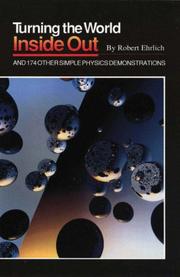| Listing 1 - 1 of 1 |
Sort by
|

ISBN: 0691023956 069108534X Year: 1990 Publisher: Princeton : Princeton University Press,
Abstract | Keywords | Export | Availability | Bookmark
 Loading...
Loading...Choose an application
- Reference Manager
- EndNote
- RefWorks (Direct export to RefWorks)
". . . dipping into this collection is much like opening a holiday gift and discovering a marvelous little toy that then holds your attention by some curious performance. . . . This book precisely reflects the way science education should be, especially at the introductory level." --From the forewordHere is a collection of physics demonstrations costing very little to produce yet illustrating key concepts in amazingly simple and playful ways. Intended for instructors, students, and curious lay readers, these demonstrations make use of easily accessible, everyday items: food coloring and glycerine swirled and then "unmixed" in a container demonstrate aspects of the entropy lawraw eggs thrown with full force at a sheet but not breaking illustrate Newton's second law (f=ma)and the reflection off a glass Christmas tree ball is the focus of an explanation on "turning the world inside out." Many of the demonstrations are either new or include innovative twists on old ideas, as in the author's simplified version of the classic "Monkey and Hunter" problem, which substitutes "diluted gravity" on an inclined plane for large apparatus. Each demonstration outlines the objective, the equipment needed, and the procedure, including, in many instances, ways for a teacher to perform the demonstration on an overhead projector. Throughout the book concrete examples are accompanied by enough theoretical background to enhance a reader's basic understanding of physical principles. Lab instructors will find that demonstrations containing a quantitative component work well as mini- experiments and as ways to illustrate the results of calculations. These diverse and flexible demonstrations will serve a wide range of educational levels, from middle school physical science to university physics.
Laboratory techniques in physics --- 53 --- Physics --- Experiments. --- 53 Physics --- Experiments
| Listing 1 - 1 of 1 |
Sort by
|

 Search
Search Feedback
Feedback About UniCat
About UniCat  Help
Help News
News